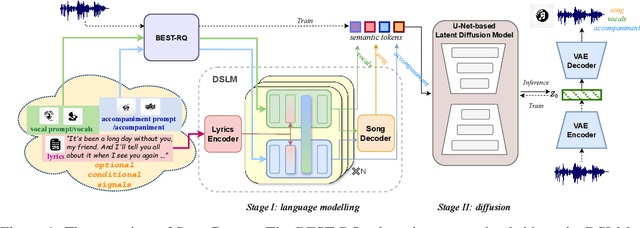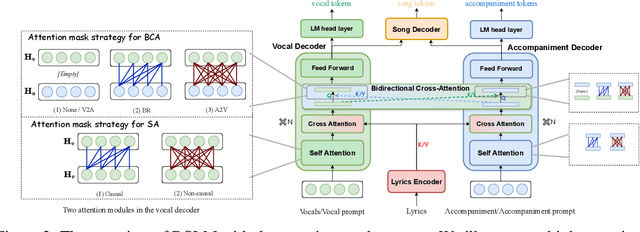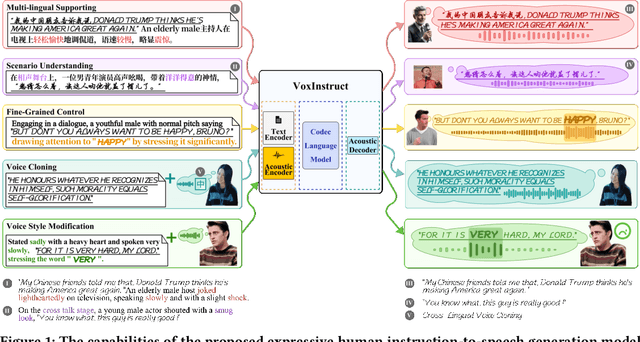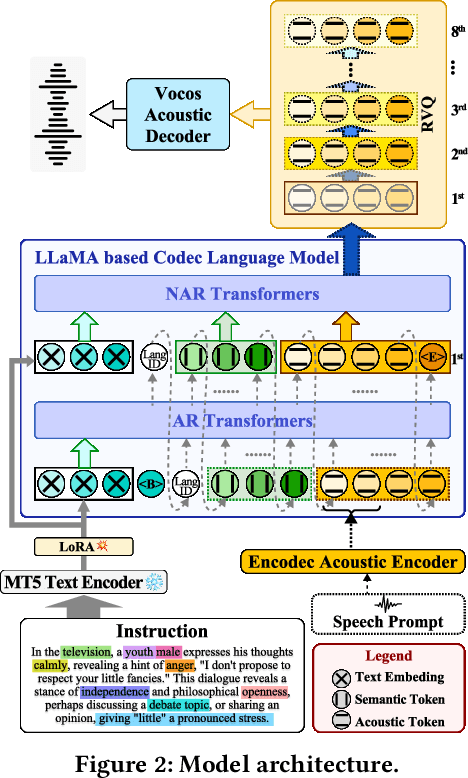Yixuan Zhou
DiffCSS: Diverse and Expressive Conversational Speech Synthesis with Diffusion Models
Feb 27, 2025Abstract:Conversational speech synthesis (CSS) aims to synthesize both contextually appropriate and expressive speech, and considerable efforts have been made to enhance the understanding of conversational context. However, existing CSS systems are limited to deterministic prediction, overlooking the diversity of potential responses. Moreover, they rarely employ language model (LM)-based TTS backbones, limiting the naturalness and quality of synthesized speech. To address these issues, in this paper, we propose DiffCSS, an innovative CSS framework that leverages diffusion models and an LM-based TTS backbone to generate diverse, expressive, and contextually coherent speech. A diffusion-based context-aware prosody predictor is proposed to sample diverse prosody embeddings conditioned on multimodal conversational context. Then a prosody-controllable LM-based TTS backbone is developed to synthesize high-quality speech with sampled prosody embeddings. Experimental results demonstrate that the synthesized speech from DiffCSS is more diverse, contextually coherent, and expressive than existing CSS systems
The Codec Language Model-based Zero-Shot Spontaneous Style TTS System for CoVoC Challenge 2024
Dec 02, 2024



Abstract:This paper describes the zero-shot spontaneous style TTS system for the ISCSLP 2024 Conversational Voice Clone Challenge (CoVoC). We propose a LLaMA-based codec language model with a delay pattern to achieve spontaneous style voice cloning. To improve speech intelligibility, we introduce the Classifier-Free Guidance (CFG) strategy in the language model to strengthen conditional guidance on token prediction. To generate high-quality utterances, we adopt effective data preprocessing operations and fine-tune our model with selected high-quality spontaneous speech data. The official evaluations in the CoVoC constrained track show that our system achieves the best speech naturalness MOS of 3.80 and obtains considerable speech quality and speaker similarity results.
SongCreator: Lyrics-based Universal Song Generation
Sep 09, 2024



Abstract:Music is an integral part of human culture, embodying human intelligence and creativity, of which songs compose an essential part. While various aspects of song generation have been explored by previous works, such as singing voice, vocal composition and instrumental arrangement, etc., generating songs with both vocals and accompaniment given lyrics remains a significant challenge, hindering the application of music generation models in the real world. In this light, we propose SongCreator, a song-generation system designed to tackle this challenge. The model features two novel designs: a meticulously designed dual-sequence language model (DSLM) to capture the information of vocals and accompaniment for song generation, and an additional attention mask strategy for DSLM, which allows our model to understand, generate and edit songs, making it suitable for various song-related generation tasks. Extensive experiments demonstrate the effectiveness of SongCreator by achieving state-of-the-art or competitive performances on all eight tasks. Notably, it surpasses previous works by a large margin in lyrics-to-song and lyrics-to-vocals. Additionally, it is able to independently control the acoustic conditions of the vocals and accompaniment in the generated song through different prompts, exhibiting its potential applicability. Our samples are available at https://songcreator.github.io/.
VQ-Flow: Taming Normalizing Flows for Multi-Class Anomaly Detection via Hierarchical Vector Quantization
Sep 02, 2024Abstract:Normalizing flows, a category of probabilistic models famed for their capabilities in modeling complex data distributions, have exhibited remarkable efficacy in unsupervised anomaly detection. This paper explores the potential of normalizing flows in multi-class anomaly detection, wherein the normal data is compounded with multiple classes without providing class labels. Through the integration of vector quantization (VQ), we empower the flow models to distinguish different concepts of multi-class normal data in an unsupervised manner, resulting in a novel flow-based unified method, named VQ-Flow. Specifically, our VQ-Flow leverages hierarchical vector quantization to estimate two relative codebooks: a Conceptual Prototype Codebook (CPC) for concept distinction and its concomitant Concept-Specific Pattern Codebook (CSPC) to capture concept-specific normal patterns. The flow models in VQ-Flow are conditioned on the concept-specific patterns captured in CSPC, capable of modeling specific normal patterns associated with different concepts. Moreover, CPC further enables our VQ-Flow for concept-aware distribution modeling, faithfully mimicking the intricate multi-class normal distribution through a mixed Gaussian distribution reparametrized on the conceptual prototypes. Through the introduction of vector quantization, the proposed VQ-Flow advances the state-of-the-art in multi-class anomaly detection within a unified training scheme, yielding the Det./Loc. AUROC of 99.5%/98.3% on MVTec AD. The codebase is publicly available at https://github.com/cool-xuan/vqflow.
VoxInstruct: Expressive Human Instruction-to-Speech Generation with Unified Multilingual Codec Language Modelling
Aug 28, 2024



Abstract:Recent AIGC systems possess the capability to generate digital multimedia content based on human language instructions, such as text, image and video. However, when it comes to speech, existing methods related to human instruction-to-speech generation exhibit two limitations. Firstly, they require the division of inputs into content prompt (transcript) and description prompt (style and speaker), instead of directly supporting human instruction. This division is less natural in form and does not align with other AIGC models. Secondly, the practice of utilizing an independent description prompt to model speech style, without considering the transcript content, restricts the ability to control speech at a fine-grained level. To address these limitations, we propose VoxInstruct, a novel unified multilingual codec language modeling framework that extends traditional text-to-speech tasks into a general human instruction-to-speech task. Our approach enhances the expressiveness of human instruction-guided speech generation and aligns the speech generation paradigm with other modalities. To enable the model to automatically extract the content of synthesized speech from raw text instructions, we introduce speech semantic tokens as an intermediate representation for instruction-to-content guidance. We also incorporate multiple Classifier-Free Guidance (CFG) strategies into our codec language model, which strengthens the generated speech following human instructions. Furthermore, our model architecture and training strategies allow for the simultaneous support of combining speech prompt and descriptive human instruction for expressive speech synthesis, which is a first-of-its-kind attempt. Codes, models and demos are at: https://github.com/thuhcsi/VoxInstruct.
Spontaneous Style Text-to-Speech Synthesis with Controllable Spontaneous Behaviors Based on Language Models
Jul 18, 2024Abstract:Spontaneous style speech synthesis, which aims to generate human-like speech, often encounters challenges due to the scarcity of high-quality data and limitations in model capabilities. Recent language model-based TTS systems can be trained on large, diverse, and low-quality speech datasets, resulting in highly natural synthesized speech. However, they are limited by the difficulty of simulating various spontaneous behaviors and capturing prosody variations in spontaneous speech. In this paper, we propose a novel spontaneous speech synthesis system based on language models. We systematically categorize and uniformly model diverse spontaneous behaviors. Moreover, fine-grained prosody modeling is introduced to enhance the model's ability to capture subtle prosody variations in spontaneous speech.Experimental results show that our proposed method significantly outperforms the baseline methods in terms of prosody naturalness and spontaneous behavior naturalness.
The THU-HCSI Multi-Speaker Multi-Lingual Few-Shot Voice Cloning System for LIMMITS'24 Challenge
Apr 25, 2024Abstract:This paper presents the multi-speaker multi-lingual few-shot voice cloning system developed by THU-HCSI team for LIMMITS'24 Challenge. To achieve high speaker similarity and naturalness in both mono-lingual and cross-lingual scenarios, we build the system upon YourTTS and add several enhancements. For further improving speaker similarity and speech quality, we introduce speaker-aware text encoder and flow-based decoder with Transformer blocks. In addition, we denoise the few-shot data, mix up them with pre-training data, and adopt a speaker-balanced sampling strategy to guarantee effective fine-tuning for target speakers. The official evaluations in track 1 show that our system achieves the best speaker similarity MOS of 4.25 and obtains considerable naturalness MOS of 3.97.
BatchNorm-based Weakly Supervised Video Anomaly Detection
Nov 26, 2023Abstract:In weakly supervised video anomaly detection (WVAD), where only video-level labels indicating the presence or absence of abnormal events are available, the primary challenge arises from the inherent ambiguity in temporal annotations of abnormal occurrences. Inspired by the statistical insight that temporal features of abnormal events often exhibit outlier characteristics, we propose a novel method, BN-WVAD, which incorporates BatchNorm into WVAD. In the proposed BN-WVAD, we leverage the Divergence of Feature from Mean vector (DFM) of BatchNorm as a reliable abnormality criterion to discern potential abnormal snippets in abnormal videos. The proposed DFM criterion is also discriminative for anomaly recognition and more resilient to label noise, serving as the additional anomaly score to amend the prediction of the anomaly classifier that is susceptible to noisy labels. Moreover, a batch-level selection strategy is devised to filter more abnormal snippets in videos where more abnormal events occur. The proposed BN-WVAD model demonstrates state-of-the-art performance on UCF-Crime with an AUC of 87.24%, and XD-Violence, where AP reaches up to 84.93%. Our code implementation is accessible at https://github.com/cool-xuan/BN-WVAD.
X-HRNet: Towards Lightweight Human Pose Estimation with Spatially Unidimensional Self-Attention
Oct 12, 2023Abstract:High-resolution representation is necessary for human pose estimation to achieve high performance, and the ensuing problem is high computational complexity. In particular, predominant pose estimation methods estimate human joints by 2D single-peak heatmaps. Each 2D heatmap can be horizontally and vertically projected to and reconstructed by a pair of 1D heat vectors. Inspired by this observation, we introduce a lightweight and powerful alternative, Spatially Unidimensional Self-Attention (SUSA), to the pointwise (1x1) convolution that is the main computational bottleneck in the depthwise separable 3c3 convolution. Our SUSA reduces the computational complexity of the pointwise (1x1) convolution by 96% without sacrificing accuracy. Furthermore, we use the SUSA as the main module to build our lightweight pose estimation backbone X-HRNet, where `X' represents the estimated cross-shape attention vectors. Extensive experiments on the COCO benchmark demonstrate the superiority of our X-HRNet, and comprehensive ablation studies show the effectiveness of the SUSA modules. The code is publicly available at https://github.com/cool-xuan/x-hrnet.
Improving Language Model-Based Zero-Shot Text-to-Speech Synthesis with Multi-Scale Acoustic Prompts
Sep 22, 2023Abstract:Zero-shot text-to-speech (TTS) synthesis aims to clone any unseen speaker's voice without adaptation parameters. By quantizing speech waveform into discrete acoustic tokens and modeling these tokens with the language model, recent language model-based TTS models show zero-shot speaker adaptation capabilities with only a 3-second acoustic prompt of an unseen speaker. However, they are limited by the length of the acoustic prompt, which makes it difficult to clone personal speaking style. In this paper, we propose a novel zero-shot TTS model with the multi-scale acoustic prompts based on a neural codec language model VALL-E. A speaker-aware text encoder is proposed to learn the personal speaking style at the phoneme-level from the style prompt consisting of multiple sentences. Following that, a VALL-E based acoustic decoder is utilized to model the timbre from the timbre prompt at the frame-level and generate speech. The experimental results show that our proposed method outperforms baselines in terms of naturalness and speaker similarity, and can achieve better performance by scaling out to a longer style prompt.
 Add to Chrome
Add to Chrome Add to Firefox
Add to Firefox Add to Edge
Add to Edge